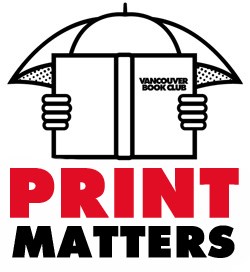 |
Print Matters is a celebration of the printed form and all the awesome local people who bring it to you: literary journals, publishers, magazines, hand presses, and independent booksellers. |
| Adam Cristobal talks about crazy theme ideas, editorial structure models and Sad Mag's approach to mentoring young writers. Bonus info: press style guides up the yin-yang. |
Sad Mag is a relatively young publication, having put out just 7 issues in the past two-and-a-half years. Its youthfulness reflects its mandate, which is to support Vancouver's diverse cultures and to support young and burgeoning writers and artists in the Lower Mainland, focusing primarily on those 15 to 30 years old. Founded by Deanne Beattie and Brandon Gaukel, the quarterly magazine started out to challenge Vancouver's reputation as "No Fun City."
Beattie and Gaukel have recently taken a step sideways, signaling a shift not only in the staff of the magazine, but also a change in the editorial structure of this non-profit, volunteer-run periodical. I recently talked with Adam Cristobal, Co Editor-in-Chief, about Sad Mag and the changes it's going through. A busy guy, Cristobal is a design intern at Ion Branding and Design, and is also finishing up his English Literature/Publishing degree at Simon Fraser University. He spent much of the past four years writing and editing for the SFU newspaper The Peak, which is where he met Deanne Beattie.
How long have you been involved with Sad Mag?
For two years. Initially Megan Lau, who used to be the Production Manager but really did a lot of editing, left to do an internship in Montréal, and Deanne asked me if I wanted to take over that position. So I did that for a few months and then I ended up working as the managing editor/editor, along with Jeff Lawrence. We would each do different levels of work depending on how free we would be for a given issue. Recently, within the last two months, Deanne and Brandon, who were the founding creative team of Sad Mag, said they wanted to step back and let somebody else take the reins. So Katie Stewart had been bugging them since the summer with all these ideas she had for the magazine and they were "What? You're crazy! We can't do that." But after a while they kind of caved in and Katie took over for Brandon. And then everyone was "So whose going to take over for Deanne?" Then Katie and Deanne approached me and asked if I wanted to do it. So for the next year or so Jeff and I will go back and forth (as Editor-in-Chief) depending on who is free for each issue. So for this issue and the one in the summer I'm going to be running the editorial show, as it were.
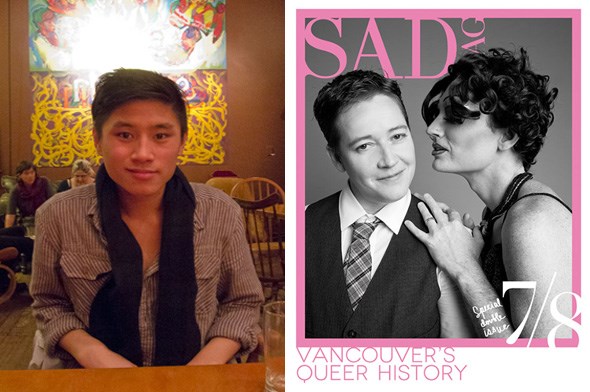
Adam Cristobal; Sad Mag's look at Vancouver's Queer History was a special double issue.
What were some of the crazy ideas that Katie had?
Oh, she just wanted to be able to plan a year in advance, instead of going one issue to one issue to one issue. From an editorial standpoint it's difficult to think that far ahead but for a quarterly magazine it affords you that gap to be able to think about what you're going to be doing for this issue and then the next one. So in a sense Katie's idea was really good because it enabled a lot of us to think about things far ahead and it is going to allow each issue to incubate a little more.
With a quarterly magazine you're writing differently, obviously, than your daily news sources, your weekly sources, and even your monthly. More and more magazines of this type are starting to think about a quarterly model because it affords you the opportunity to do more creative things, to do more heavy research, be a little more critical of your work and really expand your content and fine tune it. So it's an interesting creative endeavour.
It's really helped out in terms of us already having potential articles we can do (for future themes). If we're going to work with particular artists we've got more time to get in touch with them, all that stuff.
How are themes chosen? You mentioned Katie had come up with a whole list.
We're evaluating them. We've gone over all over them but it's hard to sit down and evaluate each of them.
We're on the cusp of going through all the copy of the upcoming one, which is the "Trans" issue. It's mainly about transplants from East to West, geographical transplants, but also male to female, etc. There may be two different covers. Readers will have a lot to reflect on.
And the one after that is going to be the "Vanimaux" issue. Katie has applied that term to it and it's derived from an art show that happened in Vancouver a while ago. Essentially it's talking about a return to a more folkie aesthetic, people want to eat natural food, etc. Sort of animal imagery and illustration. That one will be very interesting just visually speaking and that one we're thinking about it being more of a visual magazine and the launch for that might actually be an art show.
So while the next two themes have been decided upon, I see the ones coming after as a little more flexible.
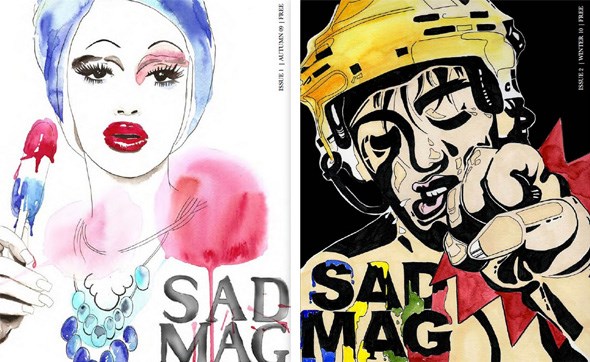
How were themes chosen before the recent editorial change?
Prior to the switch it was more of a top-down model. Deanne and Brandon would usually brainstorm themselves and then come up with the theme and we'd be "okay, cool." That was usually the easiest way for them to apply for grants because they were the ones writing the applications. Now it's more of a horizontal model so it's more about communal brainstorming, which has its ups and downs, and we're still experimenting with it.
I think the primary disadvantage of the top-down model is there was too much put on the people at the top, i.e. Deanne and Brandon. They got burnt out, which is understandable. You're in your 20s and you're putting out this magazine on the side while you work a 9-to-5 job. Hopefully with this model it's easier to divvy up the work. We do have a little bit larger staff now. We have an advertising manager and our web editor has taken on more responsibilities. And on top of that we still have Deanne and Brandon who are still acting as the sober voices in the background saying "You probably shouldn't do that. That was bad when we did that."
What role does Sad Mag's board of directors play?
Their role is slowly changing. At a formal publication you'll usually have your creatives, your editorial, and then your publisher. We would like the board to function as the publisher, in that all financial concerns go through the board. We'd like them to review grant proposals written by the creative team, scouting for grants for the magazine, etc. So a little more research intensive, a little more involved role than the board has had in the past.
Deanne is moving into more of a board position now, so having that knowledge of the creative side is something she can bring to the board. Which is good.
You've mentioned grants. Is that the main funding source for Sad Mag? Very few magazines can run solely on subscriptions.
In Vancouver it's the hard truth. And not only very few magazines but very few art magazines can run on pure subscriptions. Sad Mag has accumulated a substantial subscriber base for a magazine of its size. About 200, maybe 300, subscribers. But because of the sales model we have, we will say "We'll charge less for our subscriptions. If you want to come to a release party or a fundraiser you pay $10 for a ticket and here's a year's subscription." So we're not making the bulk of our money from that. A lot of it is from grants.
Our print run varies, depending on funding for a particular issue. The Queer History issue was 2000. The next one we're hoping for 1500-2000. It depends on how much we can spend on printing and how much advertising we are going to get. We're currently reevaluating our entire advertising dollars because with the way Maegan (Thomas, Sad Mag's new advertising manager) is trying to restructure it may afford us a larger print run. It will also depend on the demand at bookstores.
We also make money from fundraising. We just had a comedy show, so we got some money from that. And the issue releases are also a big draw for us.
You guys always have a crazy party every time an issue is released.
Yeah. There's something to be said about putting out a creative product that you want people to read but that's an individual experience. It's nice to actually have a Sad Mag community and building that community is something that Sad Mag has always been invested in. That's how we get to know the people we often feature in our magazine. That's how we often get to know the people who work at and write for the magazine. And that's really the mandate of the entire publication, to feature younger writers, younger artists. How can we reach out to that demographic? By putting on these shindigs.
You website has a lot of activity, a lot of current content between issues.
The website wasn't always as active as it is now. It used to be just a place to find information about the magazine. But Michelle Reid, who is our new web editor, has really stepped up the game to have writers post content on the website. And not necessarily fluff content but short-form content. Things that are time sensitive and we wouldn't be able to feature in the quarterlies. Say for instance if there's a really interesting show coming up in the next few weeks. We couldn't do anything about that in the quarterly, and we usually don't write things about shows in the quarterly, but it's still of interest to our demographic. So we'll feature it on the website, we'll do a little interview and the information is out there. The website also allows us to keep a presence in the time between issues.
Your themes are announced through your newsletters. How many submissions, on average, do you get for any given theme?
It depends on how you want to define a submission. Is it something that is proposed by a writer or something that is solicited by an editor to a writer? Because often we'll come up with an idea and someone will say "I have a really good writer in mind." Each issue has about 7 articles, and 2 to 3 of those will be unsolicited. The rest will come out of a topic that is inspired by the theme. We don't necessarily "assign" the stories. We'll approach a writer and say "here's this idea that we're pursuing and we think you'd be good for it. Do you want to look into this more?" And they'll go ahead and do it. In some cases we've already set up the contact interviews and we'll give that info to the writers. In others we leave it up to the writer to do the research. It depends on the writer, too, and how much guidance they want. The great thing about Sad Mag is that it's their turn to explore, so we try to provide that opportunity when the writers want it.
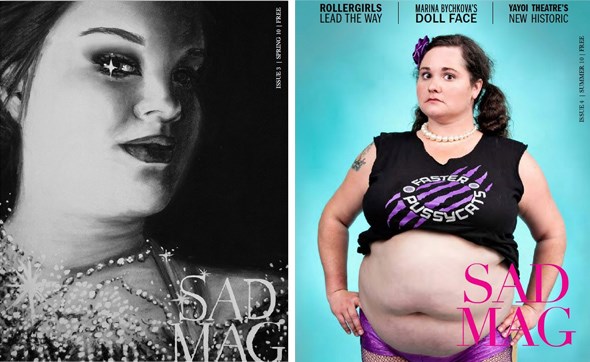
Do get many submissions that just don't fit, or the writing isn't up to the level you want?
Sad Mag tries to maintain a particular voice, a very critical voice, sometimes slightly esoteric depending on the piece. Sometimes it's really snappy. And we usually find that if (a submission) doesn't fit within those three we'll try to push the writer into one of those directions. The managing editors really engage in a lot of correspondence with the writers and work with them individually on their pieces so the writer's voice doesn't get cut out of the article. With most issues we like to really have a discussion with the writers. We'll mark up their articles and ask them "Did you think of this? Could you explore this more?"
The thing about Sad Mag is that it's not a campus publication. Saying you've had something published in Sad Mag is not the same thing as saying you had it published in your school paper. With Sad Mag a writer can say "Here's an actual publication that I submitted to and worked with and they really evaluated my work. I got to work with an editor, who also happens to be my own age."
The latest issue, Vancouver's Queer History, was a double issue. Why was that?
There was so much content, so much work, and so much we wanted to think about. There was a lot of research. You're doing a queer history issue about Vancouver. The amount of stuff, the mount of archive digging, was exponential. It just ended up being a double issue because it was such a long planning process and a long writing process. We had three main anchor pieces that ended up being written by editors, which was good, but insane. It wasn't a conscious decision but when we were brainstorming the issue...well, for myself, I got a little greedy. I said, "That's mine, that's mine." I only wrote one (on growing up gay in the suburbs). It's just the way it worked out. With such a large issue with so many tiny pieces in between, we wanted to be able to showcase these really good writers who could use 300-500 words to talk. Honestly, not every one wants to read the 1000 - 2000 word feature. And I think a lot of the writers who did the smaller pieces got more exposure because those articles got read.
The next issue launches in April. Where are you at now in the process?
Editing like mad. We've got illustrators already working. We've got photographers. I think Katie has already seen some photography. So we're at that stage. We're also at the grant writing stage because there are some deadlines coming up. Production will start in mid-March, and that's usually a weekend of madness. That's when we do the physical laying out but also a lot of detailed editing, a lot of substantive edits, and we're really refining things. Roundtable edits and press style guides up to our yin-yangs.
This is a volunteer gig for you. Why do you do it?
In this field you have to love what you do. And being involved in things like this helps you love what you do because you get to explore things on your own terms. That's why I do it. It's a large time commitment and it's difficult to work your schedule around it, but it helps you learn how to love what you do. Do I do this for free? I don't know any more. I think I'm getting a lot out of it.
Would you say that Sad Mag has been, so far, successful in meeting its mandate?
Yes, I think it has been successful. Of course we've had things that haven't worked out. We've made mistakes. And there's been a refining process. But I think largely we've been able to tell the stories we've wanted to tell. We've been able to feature the writers and the artists we've wanted to feature. And now we're building on that even more. We're hoping to establish ourselves more as the kind of place that starting writers, artists, illustrators, photographers can go and experiment and do some good work.
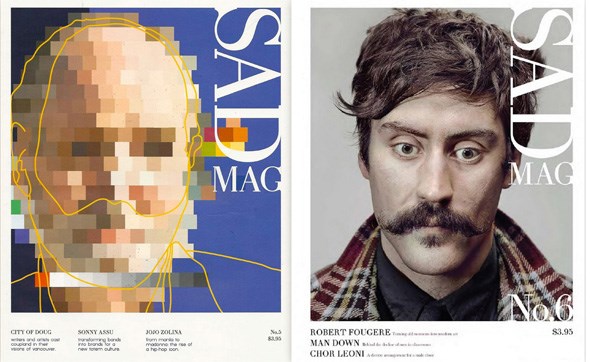
Keep an eye on sadmag.ca for details on the April launch date and party for Issue 9. The website is also the place to find a list of retailers who carry the magazine.


